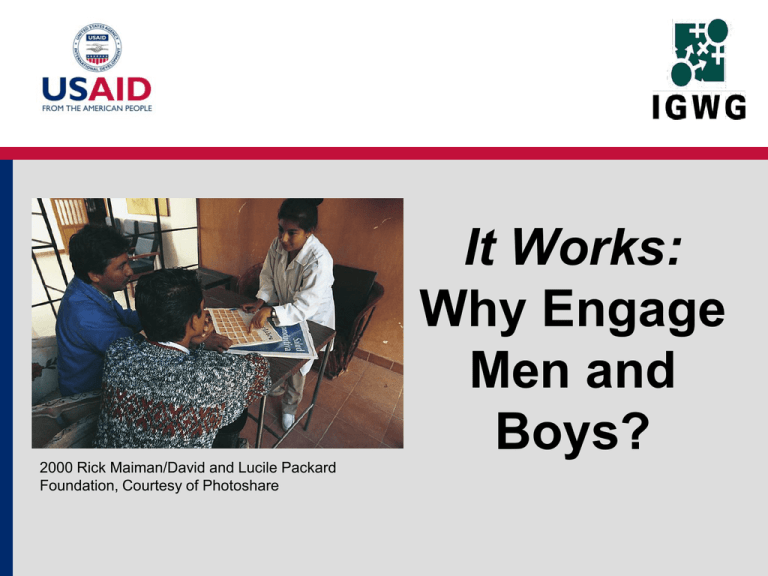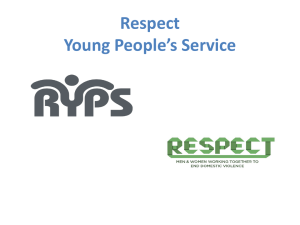It Works
advertisement

It Works: Why Engage Men and Boys? 2000 Rick Maiman/David and Lucile Packard Foundation, Courtesy of Photoshare We Have a Global Mandate to Engage Men: Cairo 1994 “Special efforts should be made to emphasize men’s shared responsibility and promote their active involvement in responsible parenthood, sexual and reproductive behaviour, including family planning; maternal and child health; prevention of STIs, including HIV; .... shared control and contribution to family income, children's education, health and nutrition; and recognition .... of the equal value of children of both sexes. Male responsibilities in family life must be included in the education of children from the earliest ages. Special emphasis should be placed on the prevention of violence against women and children.” ICPD Programme of Action, 1994, Paragraph 4.27 Growing International Consensus for Engaging Men and Boys in Sexual and Reproductive Health • • • • • • • • ICPD, Cairo, 1994 Beijing Conference on Women, 1995 World AIDS Campaign on Men and AIDS, 2000-2001 USAID Conference on Men and Sexual and Reproductive Health, 2003 Expert Meeting on Involving Men and Boys in Achieving Gender Equality, United Nations Commission on the Status of Women, 2004 Global Symposium on Engaging Men and Boys in Gender Equality, 2009 PEPFAR (emphasis on addressing male norms and behaviors) Global Health Initiative In Spite of the Global Mandate, We Have a Long Way to Go Female-controlled methods account for 74% of contraception use worldwide. Male methods—condoms and vasectomy—account for only a small percentage (26%) of global contraceptive use except in industrialized countries. Globally, there are 600,000 maternal deaths/year. Yet, many men lack information or access to maternal health services that include them. In Spite of the Global Mandate, We Have a Long Way to Go (continued) Boys and men are often socialized to use violence to display their manhood, using it against women and men. Men are more likely to experience violence at the hands of a stranger, while women are more likely to experience violence by a male partner. 30–50% of women worldwide have experienced some form of gender-based violence. 10–20% of women worldwide say their first sexual experience was coerced. In Spite of the Global Mandate, We Have a Long Way to Go (continued) Men are often pressured to prove their manhood through sexual aggression and risk taking. Globally, men have higher reported rates of partner change than women. 340 million new cases of sexually transmitted infections (STIs) per year (excluding HIV; ages 15– 49) In some developing countries, at least 3 in 10 men ages 15– 24 with STIs did not tell their partner. In Spite of the Global Mandate, We Have a Long Way to Go (continued) In many cultures, men are socialized to be selfreliant and not to seek help, including health information and care, in times of need. Young men are likely to know more about women’s bodies than about their own. In some countries, men access antiretroviral therapy (ART) for HIV later in the disease’s progression than women, with more compromised immune systems and at greater public health costs. Start by Accepting the Complexity of Gender Relations 2009 Anil Gulati, Courtesy of Photoshare • Power and vulnerability exist on multiple levels • Power and vulnerability are not mutually exclusive • Gender intersects with other systems of power (e.g., age, race, class, sexuality) • Masculinities: gender norms vary based on contextual factors and individual experiences The Driving Questions • Can men and boys—and masculinities—change? • Can they change quickly enough to matter for this generation of girls and women? Of boys and men? • How can we promote change with men and boys? What works? Can we take it to scale? • What are the implications for programs in the areas of RH, HIV/AIDS, maternal and child health (MCH), and gender-based violence? Age hierarchies Urban-rural hierarchies Social exclusion, poverty, demographic pressures Gender norms socially constructed roles and status of women and girls, men and boys Masculinities Ethnicity/ ethnic tensions Weakness/strength of the State and civil society organizations Can men and boys—and masculinities—change? Can they change quickly enough to matter for this generation for girls and women, boys and men? Changes in How we View Men • From obstacles to partners • From means to an end to subjects of their own needs • From insensitive to potential for caring • From individualists to complex subjects How can we promote change with men and boys? 2001 Edward Reilly/Lutheran World Relief, Courtesy of Photoshare Recognition of Men’s Multiple Needs • • • Men and employment Men, boys, and education Other health issues: accidents, violence, prostate cancer, infertility, mental health 2009 Anil Gulati, Courtesy of Photoshare How can we promote change with men and boys? What works? Increasing Focus on the Socialization of Boys and Men • More research on how boys and girls are socialized into a gender-segregated and unequal world • Increasing awareness that gender role socialization puts men and their partners at risk • Understanding that it is possible to question this socialization 2004 Bangladesh Center for Communication Programs, Courtesy of Photoshare How can we promote change with men and boys? What works? What to Do? Find the Entry Points • Even in settings where gender norms are rigid, there are men who question them. • Even men who generally have rigid attitudes may have some domain in which they are more gender-equitable. • Reach out to the silent majority of men and boys who do not believe in using violence and do not believe that men are inherently superior to women. • Work with women to support more gender-equitable behaviors and norms of masculinity. Finding Resistance to Prevailing Social Constructions of Manhood Identify: • Young men who empathize with the challenges girls/women face • Role models who question prevailing discourses Engage them through: • Reflection on personal and family experiences 1998 William Finger/FHI, Courtesy of Photoshare We Must Start Early and Keep Working.... a Lifecycle Approach • Young Boys/Pre-School: Engaging men as caregivers in the childcare setting and as educators • School Age: 6–12: Training of teachers, after-school programs, educational activities • Adolescence: Promoting critical thinking about gender roles, information, campaigns, group educational activities, hands-on experience in caring for children • Late Adolescence/Young Adulthood: Fatherhood, relationship courses, HIV prevention • Mid-Adulthood: RH, engaging men in maternal and child health • Late Adulthood: Men as grandfathers, preparation of next generation Common Elements of Promising Approaches • Explicit inclusion of discussions of manhood/masculinities in educational activities • Creation of an enabling environment (peers, social groups that support change) • Alliance building (using an ecological perspective to reinforce messages) • Critical reflection about violence, manhood • Vocational/direct benefit of some kind—something that directly benefits boys and men 1997 CCP, Courtesy of Photoshare WHO-Instituto Promundo Review: Evaluation Data From 57 Programs Engaging Men and Boys Type of Intervention n Effective Promising Unclear Group Education 20 - 11 9 Services-Based 8 2 4 2 Community Outreach/Mobilization 8 6 2 - Integrated (includes more than 1 of the above) 21 6 5 10 TOTAL 57 14 (24.5%) 22 (38.5%) 21 (36.8%) Gender Transformative Programs Were Even More Effective in Achieving Change (n=27 programs) 30% 44% 26% Effective Promising Unclear Take It to the Policy Level • Engaging male policymakers in open, public discussions about harmful aspects of traditional manhood • Making clear the “costs” of traditional views of manhood in campaigns, policy briefings • Engaging men and boys via the public sector: military, police, public education, health sector, national youth corps, the Scouts, technical schools • Applying a perspective of “masculinities” in national AIDS programs and public health programs 2004 Bangladesh Center for Communication Programs, Courtesy of Photoshare Thank You! References Barker G., C. Ricardo, and M. Nascimento. 2007. Engaging Men and Boys in Changing Gender-Based Inequity in Health: Evidence from Programme Interventions. Geneva: World Health Organization. Cohen, Sylvie, Michelle Burger, Akinyele Dairo, and Wariara Mbugua. 2000. It Takes 2: Partnering with Men in Reproductive and Sexual Health. New York: UNFPA. Doggett, Elizabeth and Britt Herstad. 2008. Men Matter: Scaling Up Approaches to Promote Constructive Men’s Engagement in Reproductive Health and Gender Equity. Washington: USAID|Health Policy Initiative. Available at: http://www.healthpolicyinitiative.com/Publications/Documents/722_1_Men_Matte r_IA8_FINAL.pdf. Greene, Margaret, Naomi Walston, Anne Jorgensen, Mean Reatanak Sambath, and Karen Hardee. 2006. From Adding to the Burden to Sharing the Load: Guidelines for Male Involvement in Reproductive Health in Cambodia. Washington: POLICY II Project. Available at: http://www.policyproject.com/countries.cfm?country=Cambodia. References, continued Population Reference Bureau. 2004. SysteMALEtizing Resources for Engaging Men in Sexual and Reproductive Health. Washington: PRB for the IGWG. Available at: http://www.igwg.org/Publications/Systemaletizing.aspx. UNAIDS. 2008. 2008 Report on the Global AIDS Epidemic. Geneva: UNAIDS. UNFPA. 2005. State of the World Population 2005. Partnering with Men and Boys. New York: UNFPA. Accessed at: www.unfpa.org/swp/2005/english/ch6/chap_page1.htm. UNFPA. 2008. State of the World Population 2008. New York: UNFPA. Accessed at: http://www.unfpa.org/swp/2008/en/04_reproductive_health.html#3.








